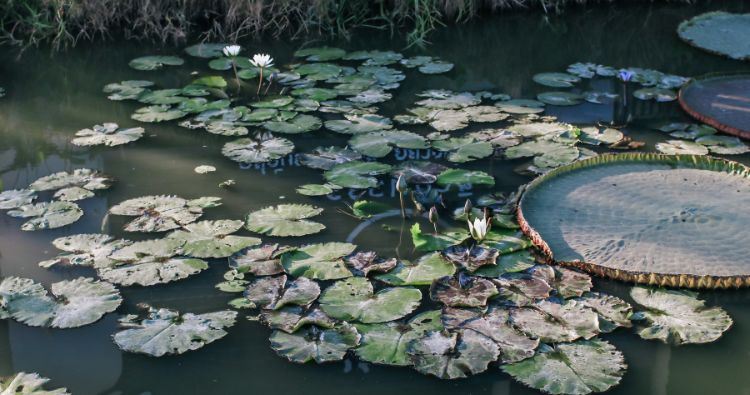From freshwater ponds to vast ocean floors, these plants not only provide oxygen and habitat for marine life but also create stunning underwater landscapes.
Chapter 1: Types of Aquatic Plants
Aquatic plants can be broadly categorized into three main types: submerged, floating, and emergent. Each type has unique characteristics and plays a different role in the ecosystem.
Submerged Plants
Submerged plants grow entirely underwater. They are anchored to the substrate by their roots but their leaves and stems remain submerged. Common examples include:
Eelgrass (Zostera marina): Found in both freshwater and marine environments, eelgrass forms dense underwater meadows that provide habitat and food for various marine species.
Hornwort (Ceratophyllum demersum): This plant is often used in aquariums due to its ability to grow quickly and provide oxygen to the water.
Waterweed (Elodea canadensis): A common plant in freshwater aquariums, waterweed is known for its rapid growth and ability to help maintain water quality.
Floating Plants
Floating plants rest on the surface of the water, with their roots dangling below. They are not anchored to the substrate, allowing them to move with the water currents. Examples include:
Duckweed (Lemna minor): One of the smallest flowering plants, duckweed forms a dense mat on the water surface, providing food for ducks and other waterfowl.
Water Hyacinth (Eichhornia crassipes): Known for its beautiful purple flowers, water hyacinth can quickly cover large areas of water, providing habitat for fish and insects.
Salvinia (Salvinia minima): A small, free-floating fern that helps reduce algae growth by shading the water surface.
Emergent Plants
Emergent plants are rooted in the substrate with their stems, leaves, and flowers extending above the water surface. These plants are often found along the edges of ponds, lakes, and wetlands. Examples include:
Cattails (Typha spp.): Tall plants with distinctive brown flower spikes, cattails provide habitat for birds and other wildlife.
Lotus (Nelumbo nucifera): Known for its large, beautiful flowers, the lotus is a symbol of purity and enlightenment in many cultures.
Bulrush (Schoenoplectus spp.): These grass-like plants grow in shallow water and are essential for stabilizing shorelines and preventing erosion.
Chapter 2: Benefits of Aquatic Plants
Aquatic plants offer numerous benefits to both the environment and human activities. Some of the key benefits include:
Oxygen Production
Aquatic plants produce oxygen through photosynthesis, which is essential for the survival of fish and other aquatic organisms. Submerged plants, in particular, release oxygen directly into the water, improving water quality and supporting aquatic life.
Habitat and Food
Aquatic plants provide habitat and shelter for a wide variety of organisms, including fish, insects, and amphibians. They also serve as a food source for many animals, from small invertebrates to large herbivorous mammals.
Water Filtration
Aquatic plants help to filter and purify water by absorbing nutrients and contaminants. This process reduces the growth of harmful algae and improves water clarity. Emergent plants, with their extensive root systems, are particularly effective at stabilizing sediment and preventing erosion.
Aesthetic Appeal
Aquatic plants enhance the beauty of ponds, lakes, and aquariums with their diverse forms, colors, and textures. They create serene and picturesque landscapes that can be enjoyed by humans and wildlife alike.
Chapter 3: Cultivating Aquatic Plants
Cultivating aquatic plants can be a rewarding hobby, whether in a backyard pond, an aquarium, or a large water garden. Here are some tips for successfully growing aquatic plants:
Choosing the Right Plants
Select plants that are suitable for the specific conditions of your water feature, such as light levels, water depth, and temperature. Research the growth habits and care requirements of each plant to ensure they thrive in your environment.
Planting Techniques
Submerged Plants: Anchor submerged plants in the substrate using weights or planting them in pots. Ensure they receive adequate light and nutrients to support their growth.
Floating Plants: Simply place floating plants on the water surface. They will spread and multiply naturally. Monitor their growth to prevent them from covering the entire surface and blocking light.
Emergent Plants: Plant emergent species along the edges of ponds or in shallow water. Ensure their roots are well-anchored in the substrate to prevent them from being dislodged.
Maintenance
Regular maintenance is essential to keep aquatic plants healthy and prevent overgrowth. Trim and remove dead or decaying plant material to maintain water quality. Monitor the nutrient levels in the water and adjust fertilization as needed.




Comments (0)